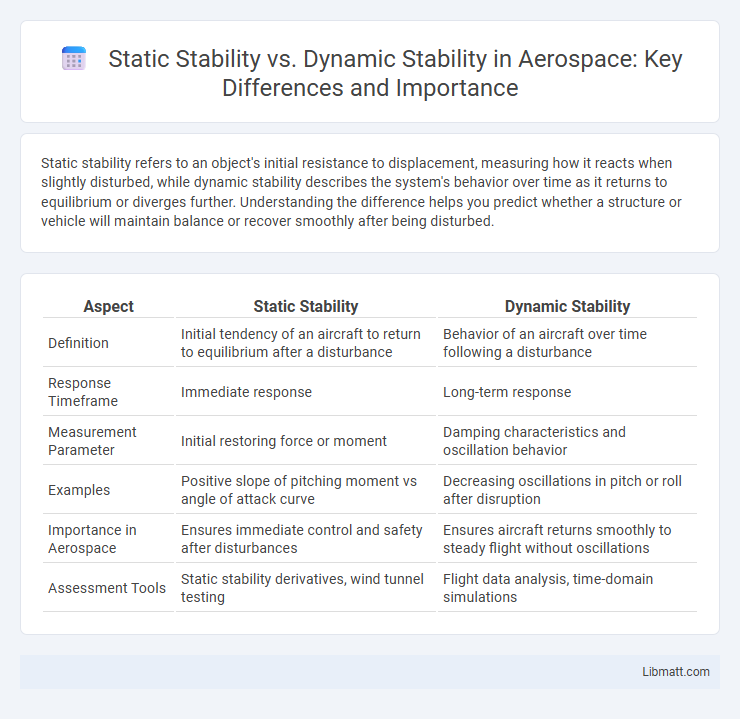Static stability refers to an object's initial resistance to displacement, measuring how it reacts when slightly disturbed, while dynamic stability describes the system's behavior over time as it returns to equilibrium or diverges further. Understanding the difference helps you predict whether a structure or vehicle will maintain balance or recover smoothly after being disturbed.
Table of Comparison
| Aspect | Static Stability | Dynamic Stability |
|---|---|---|
| Definition | Initial tendency of an aircraft to return to equilibrium after a disturbance | Behavior of an aircraft over time following a disturbance |
| Response Timeframe | Immediate response | Long-term response |
| Measurement Parameter | Initial restoring force or moment | Damping characteristics and oscillation behavior |
| Examples | Positive slope of pitching moment vs angle of attack curve | Decreasing oscillations in pitch or roll after disruption |
| Importance in Aerospace | Ensures immediate control and safety after disturbances | Ensures aircraft returns smoothly to steady flight without oscillations |
| Assessment Tools | Static stability derivatives, wind tunnel testing | Flight data analysis, time-domain simulations |
Introduction to Static and Dynamic Stability
Static stability refers to an object's initial tendency to return to its original position after a small disturbance, characterized by the slope of the restoring force or moment at equilibrium. Dynamic stability describes the behavior of the system over time, indicating whether oscillations dampen out or grow, reflecting how the system responds to continuous disturbances. Understanding both types of stability is crucial for designing structures, vehicles, or control systems to ensure Your safety and performance under varying conditions.
Defining Static Stability
Static stability refers to an object's initial resistance to displacement when subjected to a disturbance, indicating its ability to return to an equilibrium position without motion over time. This concept is crucial in fields such as aerospace and engineering, where the assessment of an aircraft's or structure's response immediately after a perturbation determines its safety and performance. Understanding static stability helps you predict how a system behaves at the moment of disturbance before any dynamic or time-dependent effects come into play.
Defining Dynamic Stability
Dynamic stability refers to an object's ability to return to its original state after a disturbance over time, incorporating the effects of motion and time-dependent forces. Unlike static stability, which considers only the initial response to a disturbance, dynamic stability evaluates how the object behaves throughout oscillations or movements following the disturbance. Understanding dynamic stability is crucial for predicting the long-term behavior of aircraft, ships, and other vehicles under varying operational conditions.
Key Differences Between Static and Dynamic Stability
Static stability measures an object's ability to return to its original position after a small displacement without movement, focusing on equilibrium states. Dynamic stability evaluates how an object responds to perturbations over time, considering oscillations and damping effects. The key difference lies in static stability's assessment of initial resistance to displacement, while dynamic stability analyzes behavior under ongoing motion and time-dependent forces.
Importance of Stability in Engineering and Aviation
Stability in engineering and aviation is critical to ensuring the safety and performance of structures and aircraft. Static stability refers to an object's ability to return to equilibrium after a small disturbance, while dynamic stability involves the system's behavior over time following that disturbance. Your understanding of these stability types is essential for designing resilient aircraft and engineering systems that can withstand environmental forces and operational stresses.
Factors Affecting Static Stability
Static stability depends heavily on the position of the center of gravity (CG) relative to the base of support; a lower CG and wider base enhance resistance to tipping. Material properties, such as rigidity and friction between contacting surfaces, also affect static stability by preventing unwanted movement. Environmental factors like surface texture and slope angle contribute significantly to the overall static stability of an object.
Factors Influencing Dynamic Stability
Dynamic stability is influenced by factors such as velocity, control surface effectiveness, and the damping characteristics of the system. The aircraft's mass distribution and aerodynamic properties play a crucial role in determining its response to disturbances over time. Environmental conditions like turbulence and gusts also affect the dynamic stability by altering the forces acting on the vehicle during motion.
Static vs Dynamic Stability: Real-World Examples
Static stability refers to an object's initial resistance to displacement, such as a tall building designed to remain upright under small winds. Dynamic stability involves the system's response over time to disturbances, exemplified by an aircraft's ability to return to steady flight after turbulence. For instance, a skyscraper exhibits static stability by resisting minor tilts, while an autonomous drone demonstrates dynamic stability by actively adjusting its flight path to maintain balance.
Implications of Stability on Design and Performance
Static stability ensures an aircraft returns to its original position after a disturbance without pilot input, influencing design choices such as wing placement and tail size for inherent balance. Dynamic stability affects how oscillations decay over time, impacting control system tuning and materials selection to enhance passenger comfort and handling responsiveness. Effective integration of both stability types optimizes overall aerodynamic efficiency, safety margins, and fuel consumption in aerospace engineering.
Summary: Choosing Between Static and Dynamic Stability
Choosing between static and dynamic stability depends on the application's requirements for responsiveness and safety. Static stability ensures an object returns to equilibrium without movement, ideal for structures where minimal displacement is critical. Dynamic stability manages system behavior over time under disturbances, crucial for vehicles and control systems requiring continuous adjustment and resilience.
Static stability vs Dynamic stability Infographic

 libmatt.com
libmatt.com